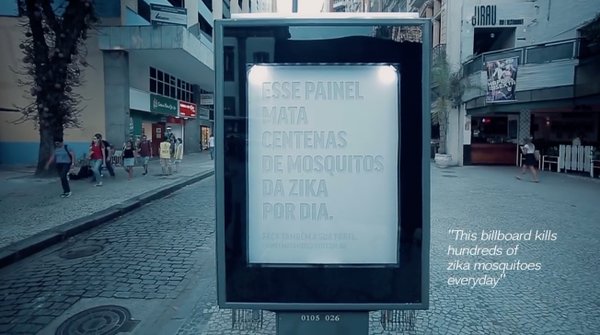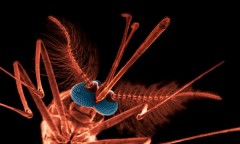By Steve Pak, | April 25, 2016

Mosquito-Killing Billboard
In South America's war on the Zika virus, a pair of Brazilian companies has developed a new billboard that attracts and kills the disease-carrying Aedes Aegypti mosquito. The small signs include containers inside that give off chemicals that mimicking bodily functions from the human body. They include lactic acid (sweat) and carbon dioxide (breath).
Like Us on Facebook
Posterscope and NBS are the two Brazilian advertising agencies that have built the bug-killing signs. Canisters inside the advertising signs can reportedly attract mosquitoes up to 2.5 miles (4 kilometers) away, according to Digital Trends.
Besides the sweet-smelling chemicals the public signs also include fluorescent light tubes that entice the biting bugs into a one-way tube. After time passes the mosquitoes die from lack of water and fill up a tray at the bottom of the sign.
Two of the new signs have been installed in the Brazilian city Rio de Janeiro. However, the two ad agencies will not sell advertising space for the billboards.
Posterscope's Otto Frossard shares that the new invention can trap big amounts of mosquitoes and save many lives. Each unit costs about $280 to manufacture.
The two ad companies have launched a website that explains how The Mosquito Killer Billboard functions. They are also offering a component view that lets DIY fans build their own version of the bug-zapping signs.
Some public health experts are critical of the high-tech billboards. They warn that the signs could attract many insects where are large human populations, according to BBC.
Brazil's first Zika outbreak took place in May 2015. Since then the World Health Organization (WHO) has declared the Zika virus as a worldwide health crisis. The dangerous disease has spread throughout Center/South America as well as the southern United States.
Zika is hard to diagnose because 80 percent of infected people show no symptoms, according to Digital Trends. Technology such as Brazil's new billboards can help to kill the carrier known as the Yellow Fever mosquito.
Dr. Chris Jackson is a pest control expert from the University of Southampton in the United Kingdom. He explains that any device or method that reduces the mosquito species' female population is a "good thing" since it is the only bug sex that bites.
This video describes the Zika virus:
-
Use of Coronavirus Pandemic Drones Raises Privacy Concerns: Drones Spread Fear, Local Officials Say

-
Coronavirus Hampers The Delivery Of Lockheed Martin F-35 Stealth Fighters For 2020

-
Instagram Speeds Up Plans to Add Account Memorialization Feature Due to COVID-19 Deaths

-
NASA: Perseverance Plans to Bring 'Mars Rock' to Earth in 2031

-
600 Dead And 3,000 In The Hospital as Iranians Believed Drinking High-Concentrations of Alcohol Can Cure The Coronavirus

-
600 Dead And 3,000 In The Hospital as Iranians Believed Drinking High-Concentrations of Alcohol Can Cure The Coronavirus

-
COVID-19: Doctors, Nurses Use Virtual Reality to Learn New Skills in Treating Coronavirus Patients











